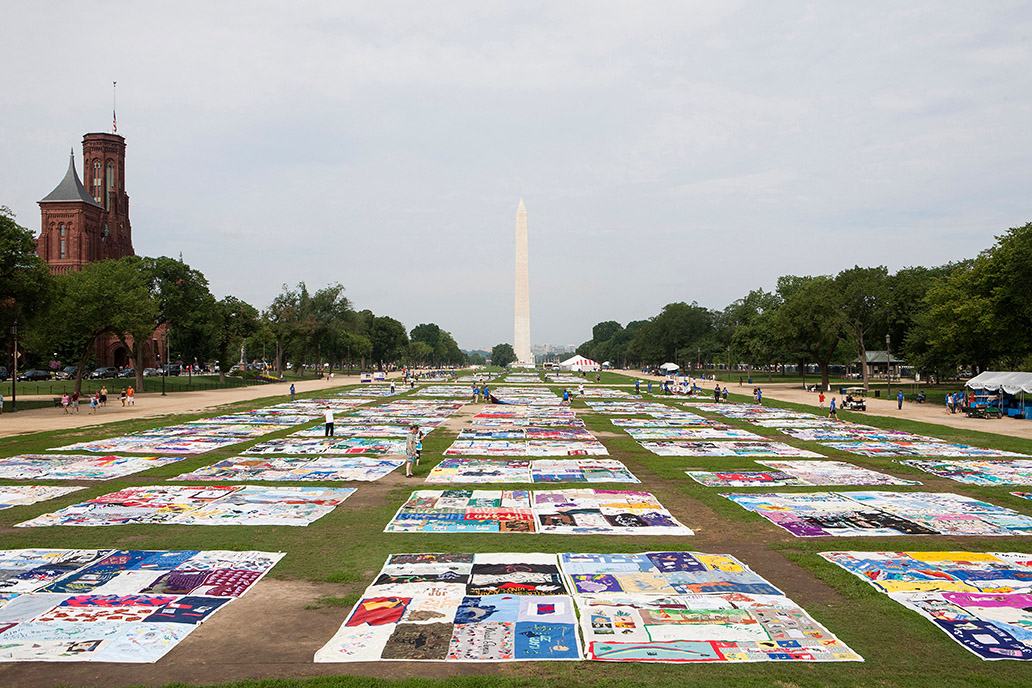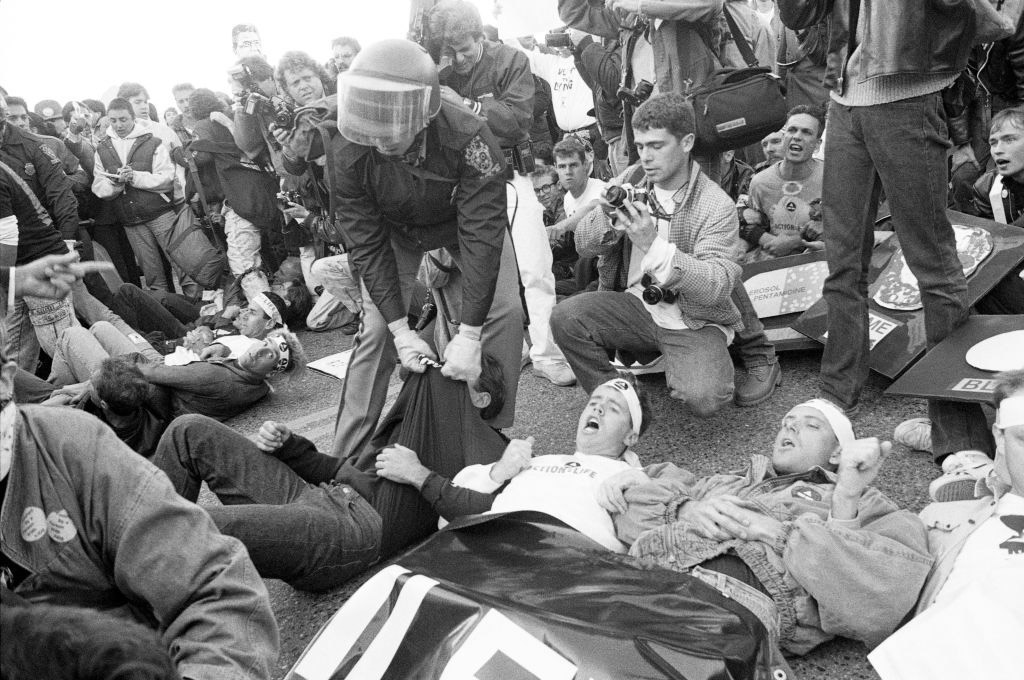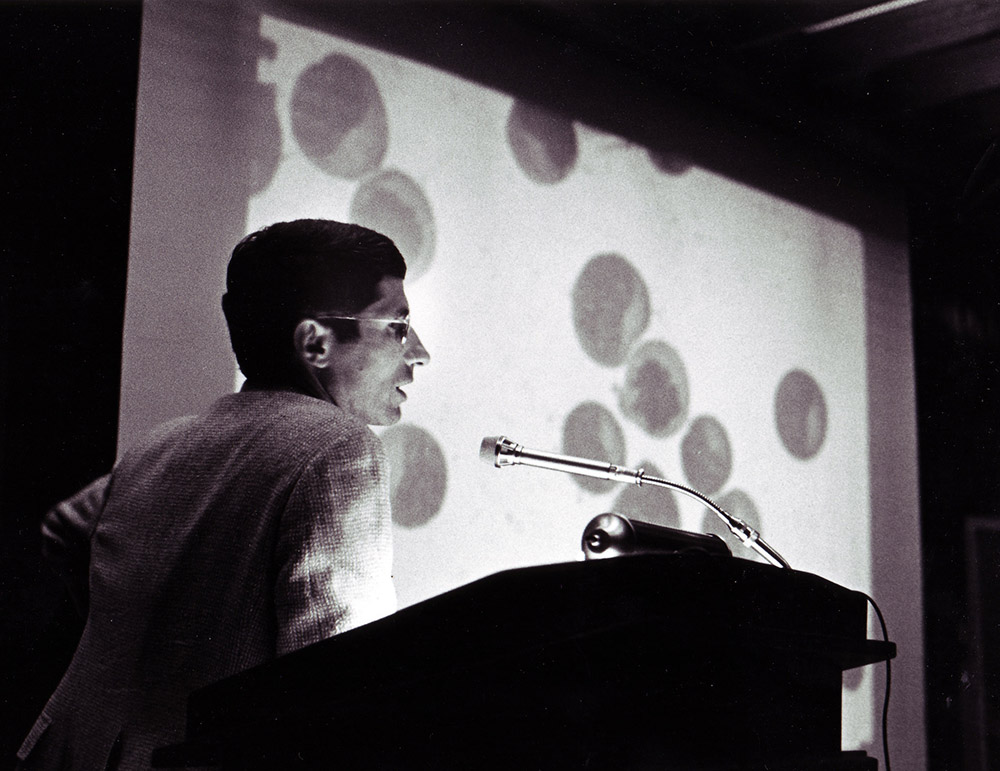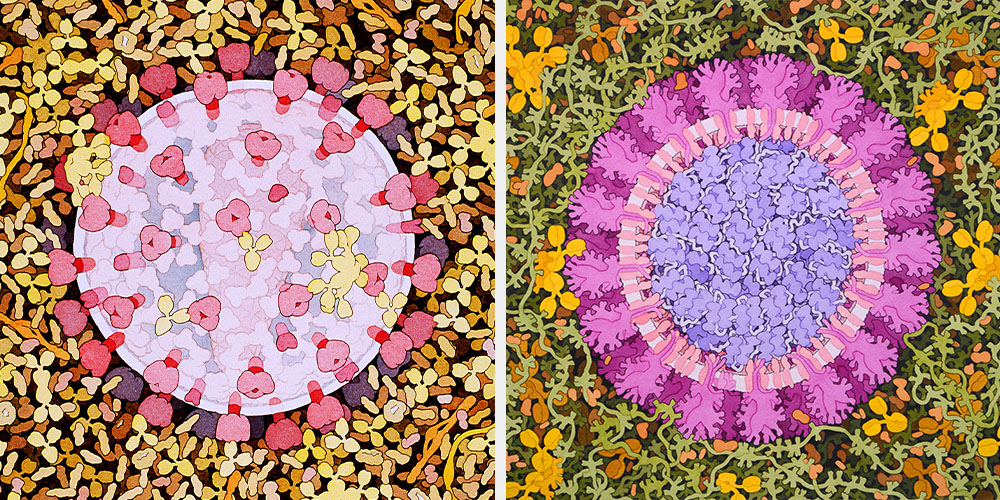Forty years after a 1981 report hinted at the coming HIV/AIDS pandemic, we look at how the response to global public health threats has changed.
When five young men in Los Angeles fell ill with a strange lung infection in early 1981, they checked into three local hospitals, baffled their doctors, and triggered an alarm that continues to ring loudly today.
Two of the men died soon after they were admitted, and biopsies of all five confirmed they were severely sick with Pneumocystis carinii pneumonia, a rare opportunistic fungus that normally only strikes people who are severely ill and immunocomprimised. It should not have infected young men between the ages of 29 and 36—let alone five at once.
So forty years ago, on June 5, 1981, the doctors reported the small cluster of mysterious cases in a short, 521-word letter to Morbidity and Mortality Weekly Report, the flagship publication of the U.S. Centers for Disease Control and Prevention (CDC).
Less than a month later, a young doctor named Paul Volberding started a new job at San Francisco General Hospital. Trained in oncology, the first patient he saw on his very first day also presented a head-scratcher of a mystery: He had Kaposi’s sarcoma.
How could that be right? This was a relatively rare cancer that almost always only occurred in older European men. It never struck young people, like the 22-year-old young man he was treating, Volberding says. And then there were more people suffering: From Los Angeles to San Francisco to New York City, a smattering of other mysterious cases were being reported.
“It was right then that we realized something was about to happen,” Volberding recalls. “By the end of 1982, the sense was growing that this was probably some new infection—and one that we didn’t understand.”
Nothing would ever be the same again.
In the next year few years, cases of the illness were reported in people with hemophilia, in an infant who had received a blood transfusion, in children born within the Haitian-American community, in intravenous drug users and their children, and in women whose sexual partners were infected with the same virus, which soon came to be called HIV and the illness it causes, AIDS.
As the AIDS pandemic turns 40, it’s worth taking a pause to explore lessons learned and where we are with the disease. After two generations, the pandemic continues to rage. Since 1981, 2 million Americans have contracted HIV, the virus that causes AIDS, and more than 700,000 people in this country have died from the disease. More than 32 million people worldwide have died from HIV/AIDS since the disease was identified, including 113,000 children and adolescents in 2018 alone—most of them in sub-Saharan Africa. Globally, about 38 million people are currently living with HIV/AIDS, including more than 1.2 million Americans, and an average of 38,000 new U.S. infections occur annually.
But it’s almost impossible to capture the scope of the HIV/AIDS pandemic by looking at those numbers alone. How has this generation-defining illness shaped modern medicine, from clinical practice to drug development to advocacy? How did it change our understanding and ability to respond to diseases as diverse as cancer and COVID-19?
Universal precautions, public art, and protests
One of the first things to change after AIDS arrived on the scene was the rise of universal blood precautions and the wearing of personal protective equipment (PPE) by health workers. Doctors had worn gloves and masks in sterile settings for many decades prior to 1981, but they were never worn in all clinical settings.
Volberding recalls how when first he was in medical school and then later as a young MD, he and his classmates were not trained to use gloves and masks universally. “We did procedures—IVs and arterial sticks—without gloves,” he says.
As fundamental as those changes were in the clinic, an even greater change to medicine was taking place on the street.
But in 1982, even before HIV was isolated and identified as the cause of AIDS, the CDC issued new precautions for health workers, including extensive guidance on wearing gloves, gowns, and masks—and specific warnings about handling syringes and other sharp objects. A few years later, in 1987, the CDC followed with more extensive universal precautions for a wider range of health-related professions, like dentists, morticians, lab workers, and janitors.
But as fundamental as those changes were in the clinic, an even greater change to medicine was taking place on the street.
Wayne Koff, founding president and CEO of the Human Vaccines Project, remembers the fall of 1987 well because he had recently moved to the Washington, D.C. area from Texas to take a position at the National Institutes of Health. He was working at the National Institute of Allergy and Infectious Diseases, and that fall he was stationed for a few weeks at the White House, not far from the National Mall, where the AIDS Memorial Quilt had been installed to to raise awareness of the disease and the terrible toll it was taking in human lives.

San Francisco AIDS activist Cleve Jones had conceived of the quilt after a much smaller public-art-as-activism project in which people wrote the names of loved ones who had died from AIDS onto poster boards that were later taped to the side of a San Francisco federal building. Jones hoped the sight of the much larger quilt with thousands of panels mourning as many people would mobilize the country.
He was right.
By the time it was assembled that first time, it covered some 1.2 million square feet, making it the largest community art project in the world. Its life-sized squares were decorated with a patchwork of photos, objets d’art, handwritten reflections, and the occasional beloved pair of acid-washed jeans—hard sewn memories of AIDS victims that demanded more empathy from everyone, including more urgent government action. More than half a million people viewed the quilt over that week in October 1987.
“It was a compelling image,” Koff says.
The impact of such an effective display reverberated far beyond HIV/AIDS. By combining art and patient advocacy into a single iconic object that encompassed a thousand stories, the quilt forever changed activism for other diseases as well, for coming pink-ribbon breast cancer campaigns to Alzheimer’s, diabetes, and many other diseases, says Koff.
FDA—The Federal Death Administration?
But it wasn’t all impressive public arts and crafts in 1987. An equally impressive and arguably more impactful form of public protest emerged that same year under the leadership of newly-formed activist groups like AIDS Coalition to Unleash Power (ACT UP) committed to using approaches that were decidedly more confrontational.
ACT UP first formed in 1987, and though nobody knew it at the time, this fledgling group would fundamentally alter the way medicine is done and how drugs are approved.
On October 11, 1988, one year after the quilt was unveiled, ACT UP organized a protest at the U.S. Food and Drug Administration in Rockville, Maryland, to call attention to perceived inaction by the Reagan administration. The protestors took a disruptive, in-your-face, and highly theatrical approach, marching in white lab coats with fake blood stains, holding up banners reading “Federal Death Administration,” and chanting things like, “Hey, Hey, FDA—how many people have you killed today?”

They demanded greater access to a promising new class of antiviral drugs that were being developed to treat HIV. (These drugs are within the class of antivirals, but they are commonly called antiretrovirals because they target HIV, which is a retrovirus.) The first of these new drugs was AZT, approved in 1987 and called the most expensive drug in history at the time. And for a while, it was the only antiretroviral available at all.
The march on the FDA marked a major turning point because it led, in just a few weeks, to the creation of a parallel track for drug review within the FDA known as accelerated approval. For years, the medical community had discussed ways to speed up the drug approval process, but that October 1988 protest had actually delivered it.
“What the HIV community said—including researchers, clinicians, patients, and advocates—was we cannot wait, and you need a faster process,” says Monica Gandhi, a professor of medicine at UCSF and the current medical director of “Ward 86,” the HIV Clinic at San Francisco General Hospital. “In the setting of a life-threatening emergency, we can’t go through the traditional slow process.”
In the United States, almost 35 years after the FDA protest, experts credit accelerated approval with having a long-lasting impact for people living with HIV/AIDS—saving countless lives—but also for Americans suffering from many other diseases. A recent perspective in the New England Journal of Medicine highlights that 85 percent of accelerated approvals in the past 10 years have been granted for various cancer indications, including more than 75 approvals for antibodies targeting the proteins PD-1 and PD-L1.
That same activist call for drug availability changed treatment for people with HIV/AIDS on a global scale. At the turn of the century, during an international AIDS meeting in Durban, South Africa, a unified call to make drugs more widely available led to an explosion of generics, at least one Big Pharma lawsuit against the government of South Africa, and eventually, the welcome reality that people living with HIV in low-income countries could be prescribed basically the same drug regimens used in the United States—but for a fraction of the cost.
“It’s been a huge, huge change,” Volberding says.
With the support of bilateral programs and international aid organizations, an HIV positive individual in South Africa can get a year’s worth of antiretrovirals for about $75 in 2018. That same course of treatment would have cost about $39,000 in the United States that year.
“The AIDS movement really fueled the sense that everybody, even if they’re marginalized, deserves good health care.”
The push to increase drug accessibility in low- and middle-income countries also threw a spotlight on neglected disease issues, global health inequities, vulnerable people, and marginalized groups as never before.
“The whole refrain of ‘leave no one behind’ is really something that grew out of the AIDS movement,” says Chris Collins, president of Friends of the Global Fight Against AIDS, Tuberculosis and Malaria. “And the AIDS movement really fueled the sense that everybody, even if they’re marginalized, deserves good health care.”
AIDS activism and accelerated approval also profoundly changed our lives by preparing the ground for COVID-19 vaccines when the need emerged last year. The Pfizer, Moderna, and Johnson & Johnson vaccines were all approved under an FDA approval process called emergency-use authorization, which was created after the 9/11 terrorist attacks on the Pentagon and the World Trade Center to help authorities rapidly develop and deploy medicines like anthrax vaccines during a crisis, but it was built upon and really grew out of those earlier accelerated approval efforts.
“That is what allowed these COVID vaccines to get approved so fast and authorized and into the arms of Americans so quickly,” says Gandhi.
A seat at the table
Following their march on the FDA, ACT UP launched another protest, called “Storm the NIH,” which featured a “die-in” at the federal agency’s sprawling Bethesda campus on May 21, 1990. Some 1,000 protesters planted tombstone-shaped signs on the lawn in front of NIH buildings to resemble a graveyard with epitaphs like “Dead from Drug Profiteers” and “Red Tape Kills Us.”
This protest also led to lasting changes in how clinical trials are designed and run—largely because Anthony Fauci, who was then and still is the director of the National Institute of Allergy and Infections, was willing to actually listen to the protestors’ demands.
“Tony Fauci’s greatest achievement in his career was when the community rose up to fight the lack of progress,” says Steven Deeks, a professor of medicine in residence at UCSF. “Tony invited them in, sat down at the table with them, became friends, and developed a true partnership.”
True to his word, in the wake of the protest, Fauci implemented changes to how clinical trials are planned, inviting activists and patient advocates into those formal meetings. He faced lots of pushback from people within the scientific and policy communities who were offended by the protest tactics.

“A lot of AIDS advocates in those early years were absolutely relentless,” says Collins of of Friends of the Global Fight Against AIDS, Tuberculosis and Malaria. “They were willing to go to jail. They were willing to put themselves at risk, but they were absolutely driven to get the change that they wanted.”
That drive, along with the fact that the activists were very sophisticated in how they went about seeking change, were among the reasons their efforts had a lasting effect, Collins says.
Engaging patients and caregivers and having their advocates present on clinical trial advisory boards became the standard approach across the fields of medicine. “Now it’s commonplace for essentially all trials that are done,” says Koff, the CEO of the Human Vaccines Project.
Vaccine and research revolutions
The decades of time and billions of dollars spent on basic research related to HIV/AIDS has fundamentally informed our understanding of the immune system and how viruses and drugs modulate it. We have uncovered a wealth of cellular, genetic, and molecular details of the immune system, devoted countless hours of synchrotron beam time and computer time to its structural biology, and developed numerous tools and assays to track, study, or respond to all sorts of viruses and other infections.
“HIV has revolutionized all of immunology, frankly,” Koff says.
Those years of work helped prepare us for the novel coronavirus. Federal investments in monoclonal antibody technology and mRNA vaccine platforms helped us hit the ground running last year when the pandemic emerged. Rapid review of research grant applications, a Congressionally mandated change driven by HIV activists decades ago, was extended by federal funding agencies in 2020 for grant applications related to COVID-19.
Most of the lab assays needed to test for coronavirus were the same as the ones designed for HIV—they just needed to be tweaked for the new virus. Laboratories around the world involved in testing for HIV were already established and able to repurpose for the new pandemic. The clinical trial networks were already in place, and they were also able to shift gears for a rapid response.

“When COVID came, the infrastructure was there, and it was almost a turnkey,” says Deeks, the doctor at UCSF.
Another important contribution that came from HIV was an appreciation for the role of T cells in immune responses. Until HIV, B cells had traditionally been seen as the critical component of the immune system for vaccines because they produce the antibodies in response to the vaccine that mount an immune response to the virus and protect people against infection. But T cells, a completely separate but significant component of the immune system, were the subject of years of study in HIV research because the primary cells targeted by the virus are CD4+ T cells.
As a result, the role of T cell immunity is appreciated better than it ever has been, and as a result, all the major clinical trials of COVID-19 vaccines have monitored T cell responses to coronavirus vaccines in addition to antibody responses. The significance of this was the realization last fall that T cell responses were broadly cross-reactive to different types of coronaviruses, which suggests that immunity conferred by a vaccine would still have potency against any viral variants that emerge.
“At this point in the vaccine campaign against COVID-19,” says Gandhi, “we are not as concerned about the variants because of our deep understanding of T cell immunity that arose from HIV.”
It would be far too easy, however, when contemplating the billions of dollars we have spent on COVID-19 vaccines on top of the billions spent on earlier vaccine research, to ignore the fact that we also had a whopping amount of luck.
“Nobody thought the mRNA vaccines were going to be 95 percent effective,” says Koff, referring to the Pfizer and Moderna COVID-19 vaccines, both of which are built upon mRNA platforms. “There wasn’t any reason to think that.”
The remarkable success of the COVID-19 vaccines is even more remarkable considering we still have no effective vaccines for HIV. Nor are we as far along with developing vaccines for TB, malaria, dengue, and many other infectious diseases, despite far more years of efforts.
“We got lucky,” says Koff. “If the coronavirus that had emerged had a spike protein as complex as the HIV envelope protein, we wouldn’t have a COVID vaccine.”
Now coming full circle, the remarkable success of the Moderna and Pfizer mRNA vaccines against COVID-19 has some people thinking of new mRNA vaccine approaches for HIV, and Moderna recently announced plans to develop mRNA vaccines against three other viral diseases, including seasonal flu and HIV.
“Our knowledge of immunology of HIV helped develop [coronavirus] vaccines,” says Gandhi, “and now I hope it will go the other way.”
Several of the experts interviewed for this story pointed out that the collective relief we feel as we contemplate the end of COVID-19 as more and more people are vaccinated is also a sobering reminder that HIV is still here.
“There’s so much farther to go,” Collins says. “Funding for key population groups in the HIV response is still significantly underfinanced, and we still have so many terrible discriminatory laws on the books for sex workers and gay people and trans people and people who inject drugs.”
“I would hope that people still realize that HIV is definitely still with us,” says Volberding. “It’s still a global pandemic and hasn’t gone away.”
Disclosures: proto.life Editor in Chief Jane Metcalfe is currently on the board of the Human Vaccines Project. proto.life Editorial Director Jason Socrates Bardi worked at both UCSF and NIAID long ago. proto.life intern Aria Vyas was an intern at Friends of the Global Fight Against AIDS, Tuberculosis and Malaria.
















